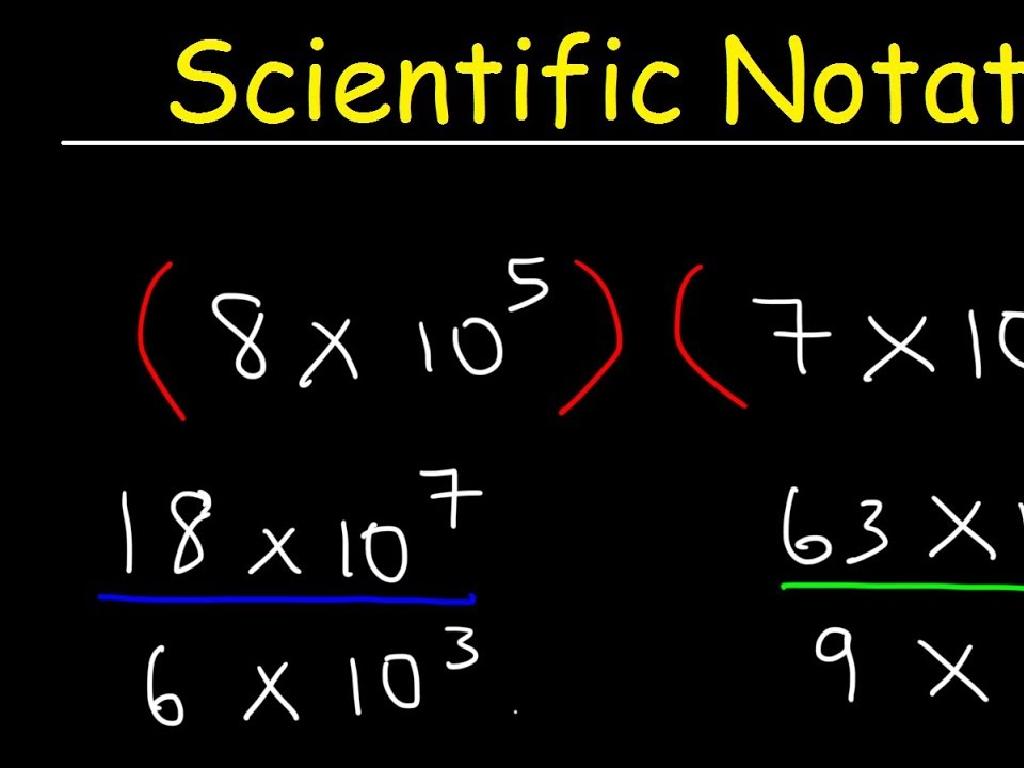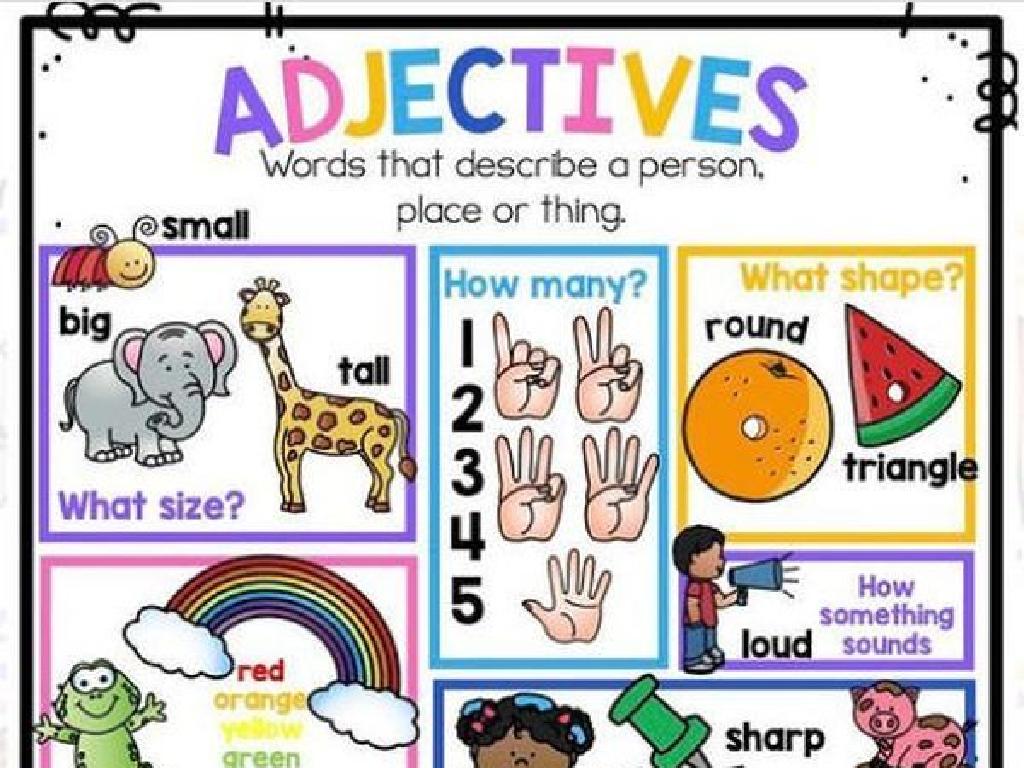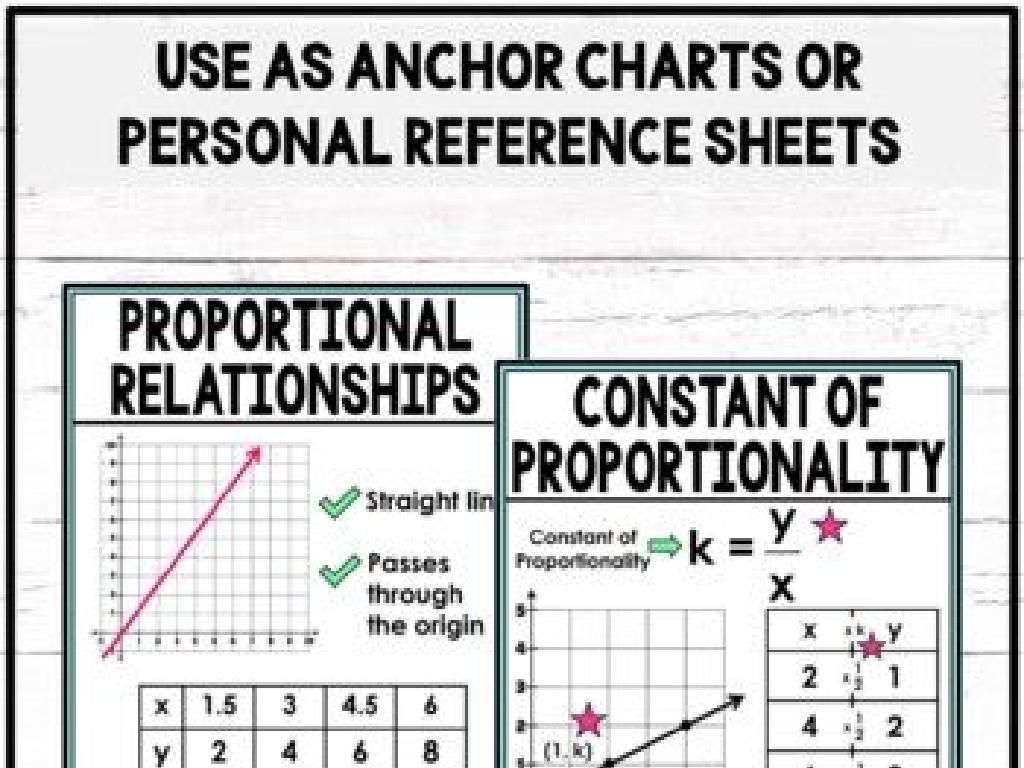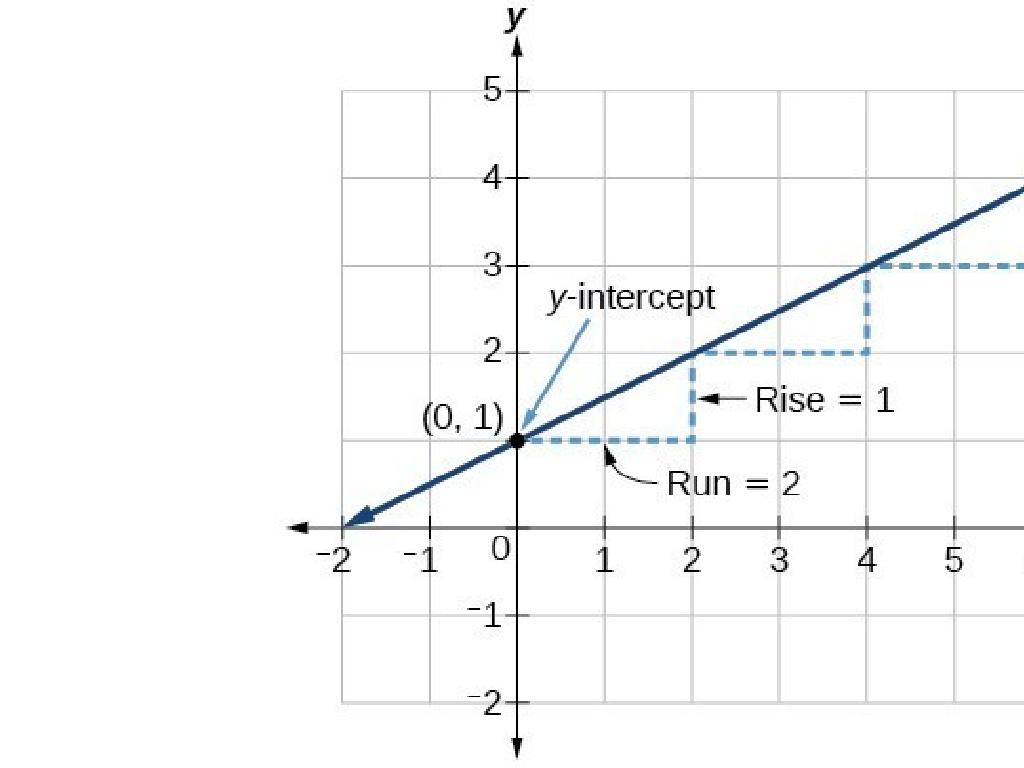Angles Of 90, 180, 270, And 360 Degrees
Subject: Math
Grade: Fourth grade
Topic: Angle Measurement
Please LOG IN to download the presentation. Access is available to registered users only.
View More Content
Exploring Angles in Our World
– What is an angle?
– An angle is where two lines meet at a point
– Angles in everyday objects
– Door corners are 90 degrees, book covers are 180 degrees
– Measuring angles with a protractor
– A tool to measure how wide an angle opens
– Types of angles: 90, 180, 270, 360 degrees
– Right angle, straight line, revolution, and complete turn
|
Begin the lesson by defining an angle as the space between two intersecting lines, with a common endpoint called the vertex. Use relatable examples like corners of a room or pages in a book to illustrate angles in the real world. Introduce the protractor as a tool for measuring angles and explain how to use it. Discuss the four types of angles that are multiples of 90 degrees, ensuring to demonstrate what each angle looks like and where it can be found in everyday life. Encourage students to think of other examples of these angles that they encounter daily.
Exploring Angles
– Understanding what an angle is
– An angle is created where two lines meet at a single point
– Identifying the vertex of an angle
– The vertex is the point where two lines intersect
– Measuring angles in degrees
– Degrees tell us the size of an angle
|
Begin the lesson by explaining that an angle is formed by two lines coming together at a point. Use a drawing of an angle on the board to point out the vertex, which is the corner or the sharp point of the angle. Explain that the space between the two lines is what we measure and we use degrees to describe how open or closed that space is. Relate the concept of degrees to a circle, which has 360 degrees. This will set the foundation for understanding specific types of angles like 90-degree (a right angle), 180-degree (a straight line), and so on. Have some real-life objects like a book or a door to demonstrate right angles and straight angles.
Exploring Types of Angles
– Acute angles: less than 90°
– Smaller than a right angle, like a sharp pencil tip
– Right angles: exactly 90°
– Like the corners of a square or the hands of a clock at 3 o’clock
– Obtuse angles: 90° to 180°
– Wider than a right angle but not a straight line, like a fan slightly open
– Straight angles: exactly 180°
– A flat line, like a ruler’s edge or horizon
|
This slide introduces students to the basic types of angles they will encounter in geometry. Acute angles are sharp and small, less than 90 degrees. Right angles are the most common type of angles, forming a perfect L shape and are exactly 90 degrees. Obtuse angles are larger than right angles but do not extend to a straight line, falling between 90 and 180 degrees. Straight angles are like a straight line, measuring exactly 180 degrees. Use everyday objects to help students visualize these angles, such as a pizza slice for acute angles, a book for right angles, a fan for obtuse angles, and a stretched out piece of string or the edge of a desk for straight angles. Encourage students to find and identify angles in the classroom for a practical understanding.
Exploring Right Angles
– What is a right angle?
– A right angle measures exactly 90 degrees.
– Right angles in shapes
– Like the corner of a square or rectangle.
– Right angles around us
– Examples: book corners, where two streets meet.
– Recognizing right angles
|
This slide introduces students to the concept of right angles as a fundamental part of angle measurement. A right angle is one that measures exactly 90 degrees, which is a quarter turn. It’s commonly seen in various geometric shapes like squares and rectangles. To help students identify right angles in the real world, use everyday examples such as the corners of a book or where two streets intersect at a crossroads. Encourage students to look for right angles in the classroom and at home to reinforce their understanding. This will help them recognize right angles in different contexts and understand their significance in geometry.
Exploring Straight Angles
– Straight angle equals 180 degrees
– It’s half of a full rotation or circle
– Appears as a straight line
– Like the edge of your desk or the horizon
– Examples in everyday life
– Significance of straight angles
– They help us understand direction and navigation
|
A straight angle is a fundamental concept in geometry, representing a half turn or 180 degrees. It’s crucial for students to recognize that a straight angle is essentially the straight line they see in objects like the edge of a desk or the line where the sky meets the land or sea, known as the horizon. These real-world examples help solidify the concept. Emphasize the importance of straight angles in understanding directions, maps, and navigation. Encourage students to find and draw straight angles, and to consider how these angles appear in various contexts, such as in art, architecture, and nature.
Understanding Reflex Angles
– Reflex angle definition
– An angle that measures more than 180° but less than 360°
– Greater than 180 degrees
– Less than 360 degrees
– Clock hand sweep example
– Like when clock shows 9:15, the angle is a reflex angle
|
A reflex angle is one that measures more than 180 degrees but less than 360 degrees. It’s like a larger sweep of a clock hand, going beyond a straight line. A good example for the students to visualize is the angle between the hands of a clock at 9:15, which is more than a half-circle but less than a full circle. Encourage students to think of other instances where they might encounter reflex angles in real life. During the lesson, use a clock with movable hands to demonstrate how reflex angles can change over time as the minute hand moves around the clock face.
Understanding Full Rotation
– A full rotation equals 360 degrees
– It forms a complete circle
– Examples: spinning top, clock face
– Like a spinning top making a whole turn, or the hands of a clock going all the way around.
– Recognizing full rotations in daily life
– Spot full rotations in objects like wheels or fans.
|
A full rotation is when a shape or point turns all the way around and ends up where it started, making a 360-degree turn. It’s like when you spin around once completely or when the minute hand on a clock goes from 12 all the way around back to 12. This concept is fundamental in understanding how angles work and is a building block for learning about geometry. Encourage students to think of examples of full rotations they see in their daily lives, such as a bicycle wheel or a merry-go-round, to help solidify their understanding.
Measuring Angles with a Protractor
– Using a protractor to measure
– A protractor helps us find how wide an angle opens
– Place protractor on the vertex
– The vertex is where the two lines meet
– Align angle’s side with zero
– The zero line is the baseline for our measurement
– Read the measurement accurately
– The number where the other side crosses is our angle
|
This slide introduces students to the use of a protractor for measuring angles, which is a key skill in understanding geometry. Start by explaining what a protractor is and its purpose. Demonstrate how to place the protractor so that its center is on the vertex of the angle. Emphasize the importance of aligning one side of the angle with the zero line on the protractor for an accurate measurement. Show how to read the number on the protractor where the second side of the angle crosses to find the angle’s measurement. Provide examples of angles that are 90, 180, 270, and 360 degrees. Encourage students to practice with a protractor in class, using printed angle worksheets or by drawing their own angles.
Let’s Practice Measuring Angles!
– Learn to use a protractor
– Classify angles by type
– Right (90°), straight (180°), reflex (>180°), full rotation (360°)
– Pair up for a measuring activity
– Work with a classmate to measure and record angles
– Find angles in the classroom
– Look for real-life examples of each angle type around us
|
This slide is designed to be an interactive class activity where students will apply their knowledge of angles in a hands-on way. Begin by demonstrating how to use a protractor to measure angles. Review the types of angles: right angles are 90 degrees, straight angles are 180 degrees, reflex angles are greater than 180 degrees, and a full rotation is 360 degrees. Students will then pair up and use protractors to find and measure various angles within the classroom environment. Encourage them to identify and classify each angle they measure. This activity will help solidify their understanding of angle measurement and the use of a protractor, as well as enhance their ability to recognize angles in everyday objects.
Class Activity: Angle Hunt
– Search for angles in the classroom
– Draw angles on your worksheet
– Use a protractor or angle ruler if you have one
– List items with different angles
– Right angles in books, straight angles in pencils
– Share your angle discoveries
– Discuss the variety of angles found
|
This activity is designed to help students recognize angles in everyday objects. Encourage them to look for right angles (90 degrees), straight angles (180 degrees), reflex angles (between 180 and 360 degrees), and full rotation angles (360 degrees) in the classroom. Provide worksheets with angle drawings for reference. Students should draw the angles they find and list the corresponding classroom items. After the hunt, facilitate a discussion where students can share their findings and learn from each other. Possible variations of the activity could include finding angles in the schoolyard, in pictures, or creating angles using their bodies.





